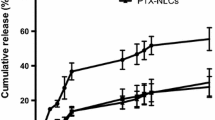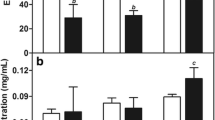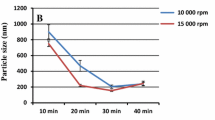Abstract
Hydrophobic nature of anti-cancer drugs not only imparts different pharmacokinetic barriers in drug delivery, but also associates with off-target toxicity and low-dose exposure of drug at the tumor site which is subsequently responsible for the development of multi-drug resistance. This study describes a water-in-oil emulsion templated reverse-phase evaporation strategy, using Span 120 as non-ionic surfactant, for the synthesis of tamoxifen-loaded niosomes. The dicetyl phosphate and Span 120 were used to engineer niosomes for sustained drug release over 12 h and improved surface morphology. The spherical niosomes were 260–300 nm in size with − 34.6 mV zeta potential. The scanning electron microscopy revealed a rough texture on the surface of niosomes. Niosomes released the drug in first-order and sustained release pattern up to 12 h. Cholesterol was embedded in the outer hydrophobic surface of niosomes, via inclusion in oil phase, to enhance the interaction with lipid bilayer of the cells. Niosomes were able to improve the cellular uptake of tamoxifen and introduced apoptosis (29%) as major mechanism of cell death as compared to necrosis (17%). DSC and XRD studies revealed the crystalline nature of the drug inside niosomes while FTIR displayed chemical stability of the drug after entrapment. After encapsulation inside niosomes, the anti-cancer activity of tamoxifen was improved up to five times with IC50 reduced from 1 μM to 0.2 μM against MCF-7 cells. Cytotoxicity and sulforhodamine B assay revealed the apoptotic cell death. The unloaded niosomes alone showed no toxicity to the cells and presented a biocompatible nanoscale delivery platform for hydrophobic anti-cancer drugs.

Graphical abstract




Similar content being viewed by others
References
Agarwal R, Katare O, Vyas S (2001) Preparation and in vitro evaluation of liposomal/niosomal delivery systems for antipsoriatic drug dithranol. Int J Pharm 228:43–52
Alexis F, Pridgen E, Molnar LK, Farokhzad OC (2008) Factors affecting the clearance and biodistribution of polymeric nanoparticles. Mol Pharm 5:505–515
Azeem A, Anwer MK, Talegaonkar S (2009) Niosomes in sustained and targeted drug delivery: some recent advances. J Drug Target 17:671–689
Bakshi H et al (2010) DNA fragmentation and cell cycle arrest: a hallmark of apoptosis induced by crocin from Kashmiri saffron in a human pancreatic cancer cell line. Asian Pac J Cancer Prev 11:675–679
Basha M, Abd El-Alim SH, Shamma RN, Awad GE (2013) Design and optimization of surfactant-based nanovesicles for ocular delivery of clotrimazole. J Liposome Res 23:203–210
Baum M, Budzar A, Cuzick J, Forbes J, Houghton J, Klijn J, Sahmoud T (2002) Anastrozole alone or in combination with tamoxifen versus tamoxifen alone for adjuvant treatment of postmenopausal women with early breast cancer: first results of the ATAC randomised trial. Lancet (London, England) 359:2131–2139
Bayindir ZS, Yuksel N (2010) Characterization of niosomes prepared with various nonionic surfactants for paclitaxel oral delivery. J Pharm Sci 99:2049–2060
Bourquin J, Milosevic A, Hauser D, Lehner R, Blank F, Petri-Fink A, Rothen-Rutishauser B (2018) Biodistribution, clearance, and long-term fate of clinically relevant nanomaterials. Adv Mater 30:1704307
Date AA, Joshi MD, Patravale VB (2007) Parasitic diseases: liposomes and polymeric nanoparticles versus lipid nanoparticles. Adv Drug Deliv Rev 59:505–521
Davies C, Pan H, Godwin J, Gray R, Arriagada R, Raina V, Abraham M, Medeiros Alencar VH, Badran A, Bonfill X, Bradbury J, Clarke M, Collins R, Davis SR, Delmestri A, Forbes JF, Haddad P, Hou MF, Inbar M, Khaled H, Kielanowska J, Kwan WH, Mathew BS, Mittra I, Müller B, Nicolucci A, Peralta O, Pernas F, Petruzelka L, Pienkowski T, Radhika R, Rajan B, Rubach MT, Tort S, Urrútia G, Valentini M, Wang Y, Peto R, Adjuvant Tamoxifen: Longer Against Shorter (ATLAS) Collaborative Group (2013) Long-term effects of continuing adjuvant tamoxifen to 10 years versus stopping at 5 years after diagnosis of oestrogen receptor-positive breast cancer: ATLAS, a randomised trial. Lancet 381:805–816
Devaraj GN, Parakh S, Devraj R, Apte S, Rao BR, Rambhau D (2002) Release studies on niosomes containing fatty alcohols as bilayer stabilizers instead of cholesterol. J Colloid Interface Sci 251:360–365
Fisher B, Costantino JP, Wickerham DL, Cecchini RS, Cronin WM, Robidoux A, Bevers TB, Kavanah MT, Atkins JN, Margolese RG, Runowicz CD, James JM, Ford LG, Wolmark N (2005) Tamoxifen for the prevention of breast cancer: current status of the National Surgical Adjuvant Breast and Bowel Project P-1 study. J Natl Cancer Inst 97:1652–1662
Garay RP, El-Gewely R, Armstrong JK, Garratty G, Richette P (2012) Antibodies against polyethylene glycol in healthy subjects and in patients treated with PEG-conjugated agents. Expert Opin Drug Deliv 11:1319–1323
Gottesman MM, Fojo T, Bates SE (2002) Multidrug resistance in cancer: role of ATP–dependent transporters. Nat Rev Cancer 2:48–58
Guinedi AS, Mortada ND, Mansour S, Hathout RM (2005) Preparation and evaluation of reverse-phase evaporation and multilamellar niosomes as ophthalmic carriers of acetazolamide. Int J Pharm 306:71–82
Gursoy RN, Benita S (2004) Self-emulsifying drug delivery systems (SEDDS) for improved oral delivery of lipophilic drugs. Biomed Pharmacother 58:173–182
Hao Y, Zhao F, Li N, Yang Y, Li K (2002) Studies on a high encapsulation of colchicine by a niosome system. Int J Pharm 244:73–80
Javed I, Hussain SZ, Ullah I, Khan I, Ateeq M, Shahnaz G, Rehman H, Razi MT, Shah MR, Hussain I (2015) Synthesis, characterization and evaluation of lecithin-based nanocarriers for the enhanced pharmacological and oral pharmacokinetic profile of amphotericin B. J Mater Chem B 3:8359–8365
Javed I, Hussain SZ, Shahzad A, Khan JM, ur-Rehman H, Rehman M, Usman F, Razi MT, Shah MR, Hussain I (2016) Lecithin-gold hybrid nanocarriers as efficient and pH selective vehicles for oral delivery of diacerein—in-vitro and in-vivo study. Colloid Surf B 141:1–9
Ke PC, Lin S, Parak WJ, Davis TP, Caruso F (2017) A decade of the protein corona. ACS Nano 11:11773–11776
Kedar R, Bourne TH, Collins W, Campbell S, Powles T, Ashley S, Cosgrove D (1994) Effects of tamoxifen on uterus and ovaries of postmenopausal women in a randomised breast cancer prevention trial. Lancet 343:1318–1321
Khoee S, Hassanzadeh S, Goliaie B (2007) Effects of hydrophobic drug–polyesteric core interactions on drug loading and release properties of poly (ethylene glycol)–polyester–poly (ethylene glycol) triblock core–shell nanoparticles. Nanotechnology 18:175602
Krishnamurthy S, Vaiyapuri R, Zhang L, Chan JM (2015) Lipid-coated polymeric nanoparticles for cancer drug delivery. Biomater Sci 3:923–936
Lin G-J, Jiang G-B, Xie Y-Y, Huang H-L, Liang Z-H, Liu Y-J (2013) Cytotoxicity, apoptosis, cell cycle arrest, reactive oxygen species, mitochondrial membrane potential, and western blotting analysis of ruthenium (II) complexes. J Biol Inorg Chem 18:873–882
Malam Y, Loizidou M, Seifalian AM (2009) Liposomes and nanoparticles: nanosized vehicles for drug delivery in cancer. Trends Pharmacol Sci 30:592–599
Mehta S, Jindal N (2013) Formulation of tyloxapol niosomes for encapsulation, stabilization and dissolution of anti-tubercular drugs. Colloid Surf B 101:434–441
Moghimi SM, Szebeni J (2003) Stealth liposomes and long circulating nanoparticles: critical issues in pharmacokinetics, opsonization and protein-binding properties. Prog Lipid Red 42:463–478
Mukherjee B, Patra B, Layek B, Mukherjee A (2007) Sustained release of acyclovir from nano-liposomes and nano-niosomes: an in vitro study. Int J Nanomedicine 2:213
Pandey SK, Ghosh S, Maiti P, Haldar C (2015) Therapeutic efficacy and toxicity of tamoxifen loaded PLA nanoparticles for breast cancer. Int J Biol Macromol 72:309–319
Petros RA, DeSimone JM (2010) Strategies in the design of nanoparticles for therapeutic applications. Nat Rev Drug Discov 9:615–627
Priyadarsini RV, Murugan RS, Maitreyi S, Ramalingam K, Karunagaran D, Nagini S (2010) The flavonoid quercetin induces cell cycle arrest and mitochondria-mediated apoptosis in human cervical cancer (HeLa) cells through p53 induction and NF-κB inhibition. Eur J Pharmacol 649:84–91
Rehman M, Madni A, Shi D, Ihsan A, Tahir N, Chang KR, Javed I, Webster TJ (2017) Enhanced blood brain barrier permeability and glioblastoma cell targeting via thermoresponsive lipid nanoparticles. Nanoscale 9:15434–15440
Ruckmani K, Sankar V (2010) Formulation and optimization of zidovudine niosomes. AAPS PharmSciTech 11:1119–1127
Shaker DS, Shaker MA, Hanafy MS (2015) Cellular uptake, cytotoxicity and in-vivo evaluation of tamoxifen citrate loaded niosomes. Int J Pharm 493:285–294
Shenoy DB, Amiji MM (2005) Poly (ethylene oxide)-modified poly (ɛ-caprolactone) nanoparticles for targeted delivery of tamoxifen in breast cancer. Int J Pharm 293:261–270
Signorell RD, Luciani P, Brambilla D, Leroux J-C (2018) Pharmacokinetics of lipid-drug conjugates loaded into liposomes. Eur J Pharm Biopharm 128:188–199
Sun T, Zhang YS, Pang B, Hyun DC, Yang M, Xia Y (2014) Engineered nanoparticles for drug delivery in cancer therapy. Angew Chem Int Ed 53:12320–12364
Usman F, Javed I, Hussain SZ, Ranjha NM, Hussain I (2016) Hydrophilic nanoparticles packed in oral tablets can improve the plasma profile of short half-life hydrophobic drugs. RSC Adv 6:94896–94904
Wang M, Siddiqui G, Gustafsson OJR, Käkinen A, Javed I, Voelcker NH, Creek DJ, Ke PC, Davis TP (2017) Plasma proteome association and catalytic activity of stealth polymer-grafted Iron oxide nanoparticles. Small 13
Zhang D, Tan T, Gao L, Zhao W, Wang P (2007) Preparation of azithromycin nanosuspensions by high pressure homogenization and its physicochemical characteristics studies. Drug Dev Ind Pharm 33:569–575
Zhao Y-Z, Lu CT, Zhang Y, Xiao J, Zhao YP, Tian JL, Xu YY, Feng ZG, Xu CY (2013) Selection of high efficient transdermal lipid vesicle for curcumin skin delivery. Int J Pharm 454:302–309
Author information
Authors and Affiliations
Corresponding authors
Ethics declarations
Conflict of interest
The authors declare that they have no conflict of interest.
Additional information
Publisher’s note
Springer Nature remains neutral with regard to jurisdictional claims in published maps and institutional affiliations.
Rights and permissions
About this article
Cite this article
Shah, H.S., Khalid, F., Bashir, S. et al. Emulsion-templated synthesis and in vitro characterizations of niosomes for improved therapeutic potential of hydrophobic anti-cancer drug: tamoxifen. J Nanopart Res 21, 25 (2019). https://doi.org/10.1007/s11051-019-4464-y
Received:
Accepted:
Published:
DOI: https://doi.org/10.1007/s11051-019-4464-y




